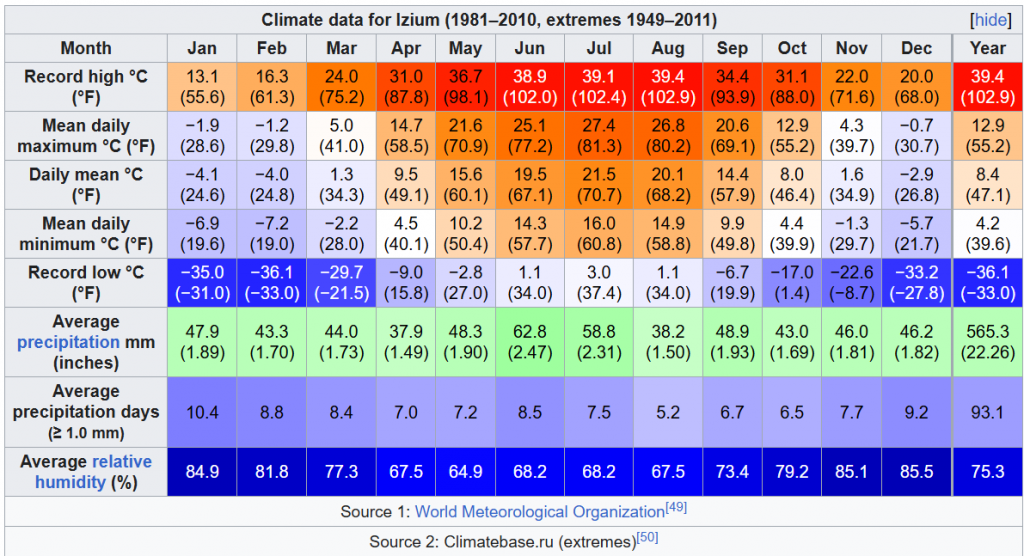
On June 9, the city of Izium in eastern Ukraine recorded a maximum temperature of +38.7°C, falling just 0.2°C short of the all-time June record of +38.9°C, set during an exceptional heat event in 2010. This places the current event among the top three hottest June days ever recorded in the region, according to the Ukrainian Hydrometeorological Center.
| Year | Peak Temperature Izium (Ukraine) | Regional Peak Temps (°C) | Notable Records |
|---|---|---|---|
| 2010 | +38.9°C (all-time June record) | Up to +40°C in parts of Ukraine, Russia, Belarus | Numerous all-time records in June and July |
| 2025 | +38.7°C (0.2°C below 2010 record) | Up to +39°C in Eastern Ukraine, +37–38°C across much of Eastern Europe | Approaching historical highs, but no new absolute records yet |
2010 heatwave included some of the highest recorded temperatures ever seen in Eastern Europe, with multiple locations hitting or exceeding +40°C, including large cities like Moscow.
The 2025 heatwave is notable for its early onset (June rather than July), with temperature anomalies approaching the 2010 peaks but slightly below the highest records.
| Aspect | 2010 Heatwave | 2025 Heatwave |
|---|---|---|
| Synoptic Pattern | Strong, persistent blocking high (Omega block) over Russia and Eastern Europe | Similar Omega block ridge centered over southern Russia and Ukraine, but slightly weaker and shorter-lived |
| Jet Stream Behavior | Significant northward meander, blocking cold Atlantic air, promoting stagnant warm air mass | Persistent ridge but some influence of a slowly shifting trough from Central Europe |
| Moisture Levels | Very dry with prolonged drought conditions | Moderately dry, but with localized drought risks increasing |
| Duration | Prolonged heat wave lasting several weeks in July and August | Intense but currently shorter, expected to last a few days to a week in June |
- Both years featured blocking high-pressure systems which suppressed rainfall and encouraged extreme heating.
- 2010 saw a longer-lasting and more intense block, contributing to an extended drought and heatwave.
- The 2025 event is characterized by a strong ridge but with some potential weakening in the coming days, potentially limiting duration.
| actor | 2010 | 2025 |
|---|---|---|
| Background Climate | Occurred during a period of accelerated global warming, but before recent rapid Arctic amplification | Occurring in a warmer baseline climate, with global temperatures ~0.5°C higher than in 2010 |
| Frequency of Heatwaves | Relatively rare event, seen as a strong anomaly | Increased frequency of heatwaves regionally, consistent with IPCC projections |
| Societal and Environmental Impact | Severe drought affecting agriculture, water shortages, forest fires in Russia | High heat stress on populations and crops, moderate drought developing, greater awareness and preparedness |
The 2010 heatwave was a wake-up call about climate risks in the region.
The 2025 heatwave occurs against the backdrop of continued warming, making such extremes more likely and intense.
Impacts
- 2010:
- Massive crop failures (grain losses estimated in millions of tons) across Russia, Ukraine, and Belarus
- Severe wildfires, especially in Russia
- Thousands of heat-related deaths in Russia and Eastern Europe
- Energy and water supply stress
- 2025:
- Crop stress and early signs of drought, especially for wheat and sunflowers
- Increased heat-related illnesses, but early public warnings may have mitigated worst health outcomes
- Fire risk rising but not yet at 2010 levels
Summary
| Feature | 2010 Heatwave | 2025 Heatwave |
|---|---|---|
| Peak Intensity | Slightly higher temperatures, longer duration | Slightly lower peak temps, shorter duration so far |
| Geographic Extent | Very broad, spanning most of Eastern Europe and western Russia | Focused on Eastern Ukraine and neighboring regions but also affecting broader Eastern Europe |
| Climate Background | Early stage of modern climate warming | Climate warming intensified, making such events more frequent |
| Societal Response | Limited early warning systems | Improved meteorological forecasts and preparedness |
Synoptic Situation in June 2025
The extreme heat was driven by a strong upper-level ridge of high pressure centered over southern Russia and eastern Ukraine. A persistent 500 hPa geopotential height anomaly—up to +2 standard deviations above the climatological mean—created a dome of stagnant, subsiding air that suppressed convection and maximized insolation.
Under cloudless skies and with weak surface winds, solar radiation exceeded 1000 W/m² at peak hours, while the dry soil and low vegetation cover (due to early-season drought conditions) amplified surface heating via the sensible heat flux.
Surface dew points remained relatively low — between 12–15°C — allowing for an intense diurnal temperature rise with minimal evaporative cooling. The heat index, however, remained close to the air temperature due to the moderate humidity.
Climatological Context
This +38.7°C reading is 5 to 7°C above the climatological June average maximum for Izium, which typically hovers around +31–32°C. While June heatwaves are not unheard of in this part of Ukraine, the intensity and early onset of this event are noteworthy.
The 2025 spring season has already shown significant thermal anomalies. May was +2.4°C above average nationwide, and June has started with positive temperature anomalies ranging from +4 to +6°C in much of eastern and southern Ukraine.
Notably, the urban heat island effect in Izium remains modest due to the city’s semi-rural geography, suggesting that this extreme was not significantly inflated by local urbanization.
Regional Pattern and Wider Impacts
This heat event is part of a broader hemispheric pattern, with a quasi-stationary Omega block observed over Eastern Europe. While cold air intrusions persist over Western Europe and Scandinavia, the eastern flank is exposed to sustained warm air advection from Central Asia and the Middle East.
High temperatures exceeding +37°C were also reported in neighboring oblasts — notably in Dnipro and Luhansk — with some automated weather stations briefly reaching +39°C, though not all are WMO-calibrated.
The sustained heat is exacerbating soil moisture deficits, increasing the risk of flash drought, particularly in steppe regions. Satellite data from MODIS and Sentinel-3 confirm declining vegetation indices (NDVI), while fire danger indices are now rated “extreme” in some districts.
Forecast Outlook
Numerical models (ECMWF, ICON, GFS) suggest the ridge will persist for another 48–72 hours, after which a shallow trough from Central Europe may introduce some instability and cloud cover, lowering temperatures slightly.
However, ensemble means continue to show above-average temperatures through mid-June, with no significant precipitation expected in the Kharkiv Oblast region for at least five days.
Closing Notes
As the planet warms, Ukraine—positioned at the crossroads of continental and subtropical influences—is likely to experience more frequent and intense heatwaves. The near-record in Izium is a stark example of this trend, and a warning signal to planners and the agricultural sector alike.
Conclusion
While the 2010 heatwave remains the benchmark for extreme summer heat in Eastern Europe, the 2025 event underscores a worrying trend: heatwaves of near-record intensity are arriving earlier in the season and becoming more frequent. These conditions demand stronger climate adaptation measures, especially in vulnerable regions like eastern Ukraine.

Source: https://en.wikipedia.org/wiki/Izium

Illustration picture: https://opiniojuris.org/2022/08/09/all-our-hope-is-in-the-famine-why-an-investigation-into-starvation-crimes-in-ukraine-is-urgently-needed/


























